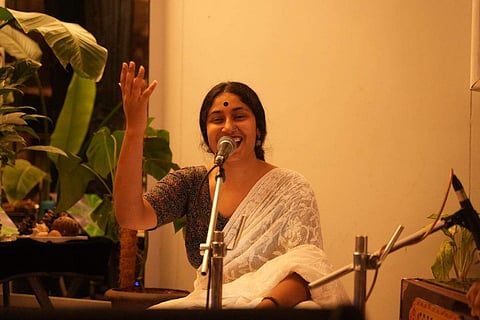Independent artist Akanksha Grover is coming to Hyderabad to hold a baithak for music connoisseurs
Whether delivering well-known poet Faiz Ahmed Faiz’s revolutionary Hum Dekhenge or legendary singer Lata Mangeshkar’s song Naam Gum Jaayega, independent artiste Akanksha Grover’s mellifluous voice evokes vivid emotions. Extremely passionate about reviving the tradition of old-style baithak, Akanksha is winning hearts with her ghazal gayiki, semi-classical renditions and inclination towards Hindustani classical music. Gracefully dressed in a sheer sari, wearing her iconic bindi, you would often come across her music videos getting viral on social media winning hearts all across. Music lovers in Hyderabad are set to watch Akanksha as she conducts a baithak, Safar-E-Mausiqui in collaboration with the city-based musical initiative Tangy Sessions. We talk to the artiste about baithak, her passion for music and the role of social media in the life of independent artists in the present time.
What is the baithak in Hyderabad all about? Please tell us what have you planned for the event.
I’ll present some ghazals, semi-classical compositions and evergreen old Bollywood songs. I often start my show with a famous nazm sung by the ghazal king Jagjit Singh. After this, I’ll go on to present renowned ghazal maestros Ustad Ghulam Ali and Mehdi Hassan’s melodies. Being a follower of Lata Mangeshkar, I incorporate her songs into my programmes. This will be followed by the interaction with the audience. I like to gauge the reactions of the listeners who sing with me alongside and often shout out requests for songs. I take immense pleasure in fulfilling their desires.
Please tell us about the tradition of baithak. Are you trying to revive the forgotten concept through your initiative?
The term baithak refers to ‘sitting’ or ‘gathering.’ Baithak is a setting where people come together to share and appreciate the beauty of music. Whether it’s a private meeting in havelis, gatherings in courtyards or other small venues, such events have a relaxed ambience where the depth of the music is more palpable. Also, as an artiste, the experience of connecting with the audience in baithaks is enriching, surpassing the impact of stage performances. The intimacy of a baithak allows me to gaze upon my listeners up close, fostering a sense of deeper connection. I want to bring back the beautiful old-world charm of baithaks in today’s time.
Could you please share a brief overview of your musical journey?
To be honest, it all started when I was only four years old. My nani’s family including my mother would sing in satsangs. So, I guess, my interest in music was kindled through the musical heritage of my maternal lineage. I still remember my parents met a music teacher to train my elder brother for some programme in his school. However, my brother showed little interest, and surprisingly, I stepped in to pick up the musical journey from there. I graduated with B Com because my parents were sceptical about me taking up music as a full-time career. However, after convincing them later, I completed my post-graduate in Hindustani classical music.
For many, classical music represents a spiritual journey. How does this aspect resonate with you?
Some years ago, I was diagnosed with Celiac disease. It’s an auto-immune condition which is not considered serious, maybe due to the lack of awareness among people. However, it’s very troublesome. There was a period in my life when I found myself grappling with depression. In response, I embarked on a journey to Himachal Pradesh, seeking solace amidst the mountains. That’s when I spent most of my time doing riyaz. I would sing happy ragas like Bageshree, Jai Jai Wanti raga, Yaman, Jhinjhoti, Bhupali among many others. Although my parents have been quite supportive all through, I believe that time was instrumental in providing the opportunity for self-discovery. That’s when I connected with my authentic self. As a consequence, I now experience a profound bond with music. I have a rented home in Himachal Pradesh and I still travel there with my dog.
Why do you feel so passionate about ghazals, or semi-classical compositions in this era when the youth is more attracted to Western music?
Although I have always learnt Hindustani classical music, I mainly perform ghazals and light music or semi-classical songs in baithaks. People often get confused between these genres. These are very different from each other. I would say Hindustani classical music can be a wonderful foundation or base if you want to explore other genres. Classical music has a sense of belongingness. But having said that, I do believe in opting for fusion routes. We can try evolving the music in order to make it more relevant to the taste of the current generation. In fact, I am planning to compose some classical bandish using different Western instruments so that I can experiment and keep the art form alive even among the youth.
According to you, what role does social media play in the professional growth of independent artistes today?
I believe that social media stands as an invaluable tool for contemporary artistes to attain recognition in the present time. Drawing from my own journey, I can affirm that it has played a pivotal role in showcasing my talent to the audience. It is apparent that numerous artistes remain hidden in the shadows due to the lack of opportunities. I guess, every independent artistes can make the best use of social media to make their presence felt.
Rs 1,199. August 18. 8 pm.
The Terracotta House, Jubilee Hills.
Mail ID: sakshisuresh.k@newindianexpress.com
Twitter: @kaithwas_sakshi

